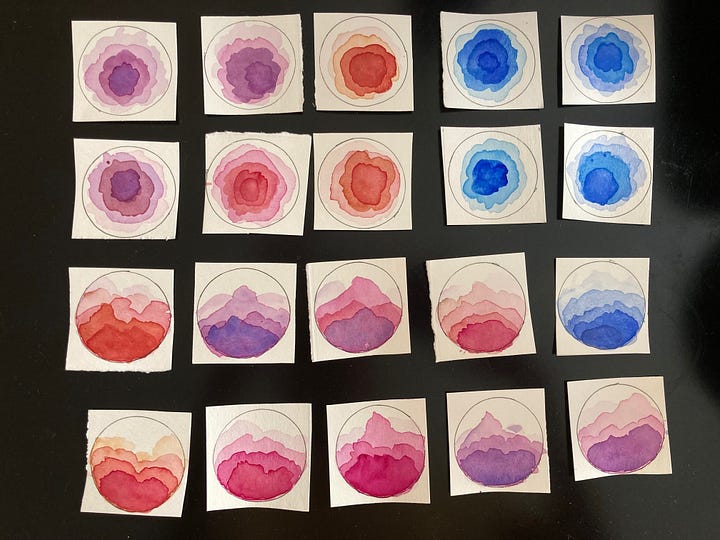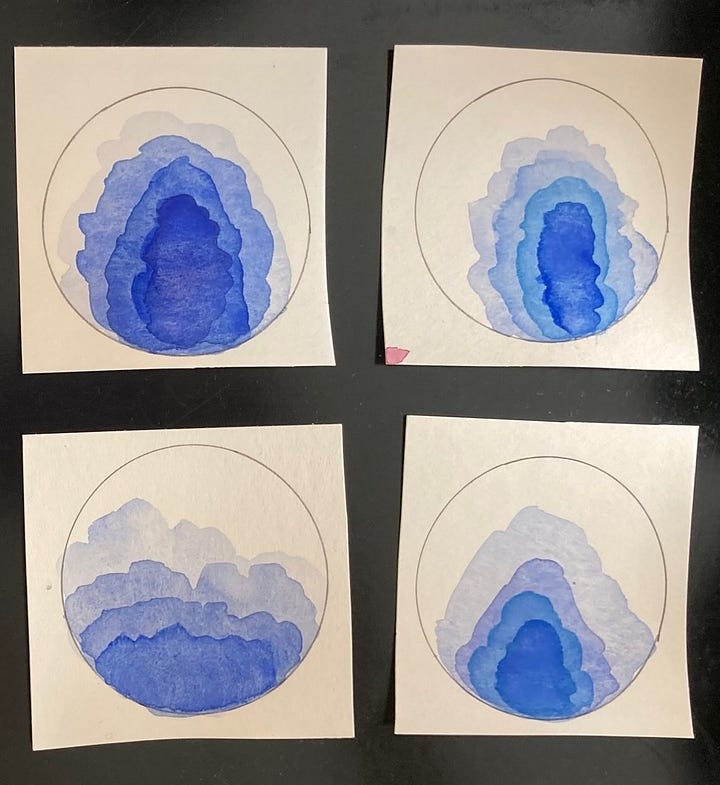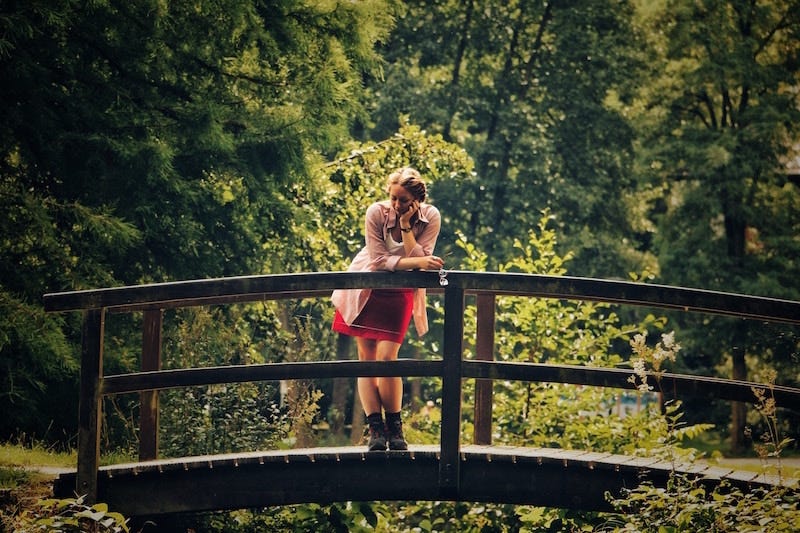Cultivating the State in Which Making Art Becomes Inevitable
On inspiration, openness, the power of creative constraints, and small challenges to get you making art regularly, plus some wonderful things to check out
"The object isn’t to make art, it’s to be in that wonderful state that makes art inevitable ."
~Robert Henri
Welcome to new subscribers—I’m so delighted and grateful you are here—and huge thanks to my paid subscribers. You are helping to sustain me and the work I do, bringing more creativity, wonder, play, and joy to our world. This is no small thing. Thank you!
Before we dive into today’s topic, here are a few Weekly Wonders that have inspired me lately and that may inspire you.
Weekly Wonders
As I ran into friends, acquaintances, and strangers at the supermarket, hair salon, or bank lately, people kept asking me, “Do you have any plans for this summer?” Nope. “Are you doing anything fun this weekend?” Nope.
That didn’t seem right, and yet, I’m limited in what I can do both by health and finances, so I chose a local play to attend this past weekend, rather than spend another weekend just hanging around the house.
Wonderful theater: Present Laughter by Noel Coward is playing at our local theater, the Nevada Theater. It was a complete delight. A madcap romp that was very well done and reminded me of the unique pleasures that seeing live theater offers.
Wonderful books: As I shared previously, I was floored by The Beauty of Ordinary Things by Harriet Scott Chessman. So I went on to read Lydia Cassatt Reading the Morning Paper, which, while lovely, did not evoke the same magic for me. Then I tried, Someone Not Really Her Mother. This slim novel is exquisite and perfect for me right now, as it is about three generations of women dealing with the complex legacy of the Holocaust and their relationships with one another. My mother was a Holocaust survivor, and I’m currently engaged (again) in doing some ancestral healing work, so this was incredibly resonant for me. The novel is so moving and beautifully told and also deals with dementia (which my mother did not have) in a beautiful, compassionate way that may be both resonant and revelatory for many readers. I highly recommend it.
Wonderful viewing: We watched two series by Ken Burns on PBS, one on Leonardo da Vinci and one on Mark Twain. Wow. Both are fascinating and complex characters with unusual lives, well told.
Making Art Inevitable
It’s a strange thing when your job is to be an artist. What your work looks like is not likely to be familiar to many people. What it takes to cultivate the state in which making art is inevitable is a tricky, subtle thing. It’s different for each person. And it’s different for the same person at various seasons in their creative life.
Cultivating wonder, curiosity, and openness is at the heart of it. As artists, we are always beginning anew. Always discovering and re-discovering—who we are, what we love, what we’re curious about or compelled by now, what calls to us, what materials we wish to work with, and how we wish to work with them. All of this is in flux.
Cultivating the state in which making art becomes inevitable requires attention, patience, trust, and experimentation. I may go for a walk or stare out the window, try reading a bit in four different books, look at images by others, watch a YouTube video about an artist or one that offers a free workshop in making art, play with partially-completed works of mine, or flip through completed ones. All in an attempt to spark the muse.
Art isn’t something I can just sit down and force myself to do. Not if I want to be happy with the result. Ignoring my muse and waiting for inspiration to strike doesn’t work either, unless you’re content with not creating much art. Encouraging that inspired state is a delicate matter that requires care and focus, repetition, showing up regularly, and a willingness to be a beginner over and over again.
I’ve written before about having an easy onramp, practices that help stimulate my muse and that are simple and enjoyable. These might include reading for inspiration or freewriting, if writing is what I’m after. Or making simple drawings or playing with color mixing, if visual art is what I’m up to. Or rolling around on the floor and stretching, if dancing is what I hope to do. Playing scales often meets this need for musicians. A simple, inviting way to begin engaging with your art form is the idea.
But you need inspiration too. Where and how you get that is going to be unique to you and change over time. Do you get inspired from nature, from other artists, from household objects, from ideas?
When I’m aiming for a particular kind of voice in my writing or style, I may need to read works that sound similar or offer a similar approach, to get the feel of it in my head or to give me permission to try a certain technique.
The Power of Creative Constraints and Challenges
I know no greater catalyst of creativity — in art or in life — than constraint. It is the boundaries, chosen or imposed, that give shape to our lives; it is within them that we become truly creative about the kind of life we want to live. Without the constraint of bones, there would be no wings.—Maria Popova, The Marginalian
One of the most helpful tools for stimulating creativity is having some sort of challenge, constraint, or limitation. This past month or so, I’ve been playing with making watercolor “inchies.” Two-inch by two-inch pieces of paper with a circle drawn on them, in which I play with two related colors of paint, combining them in various shades. And with the added limitation of layering them in one of three possible basic patterns—landscape, flower, or geode. I wrote about this here at the start of the challenge.


Since then, I’ve been playing with adding line drawings on top of some of them, cutting some of the circles out, collaging with them, making little accordion books out of the collaged bits, and arranging them in various pleasing combinations.
This simple, beautiful challenge has been utterly fun and engaging, and it has taught me a great deal about watercolor, at which I’m a complete novice. Having an ongoing challenge or project also solves the problem of what am I going to make today?
And the limitations or constraints allow for endless variations, including bending or breaking the rules in various ways to see what results. All this helps me discover what pleases me, what intrigues me, what feeds me, and what I wish to explore further.
Repetition is incredibly helpful and valuable in making art—both for keeping going and for learning. Having low expectations about the results is also key. This subverts the stultifying effects of the inner critic.
If you’re feeling stumped for what to make or how to get started, I’ll offer some prompts in our Wonder Sparks below.
Our Weekly Wonder Sparks are a benefit for paid subscribers. Become a paid subscriber, support my work, and get wonderful benefits for yourself, including the weekly Wonder Sparks to help you cultivate more wonder, creativity, play, joy, and soul in your life.





